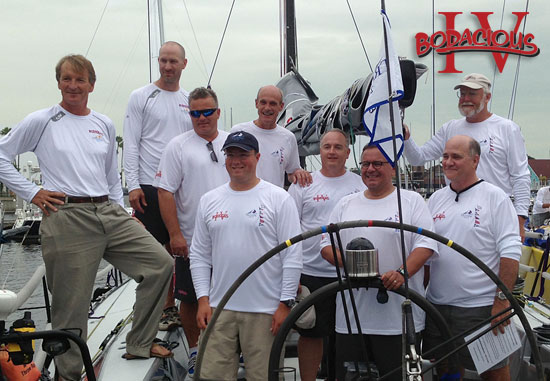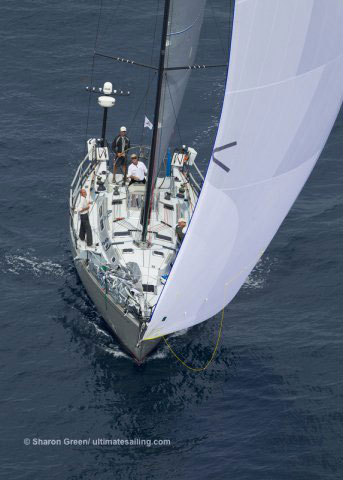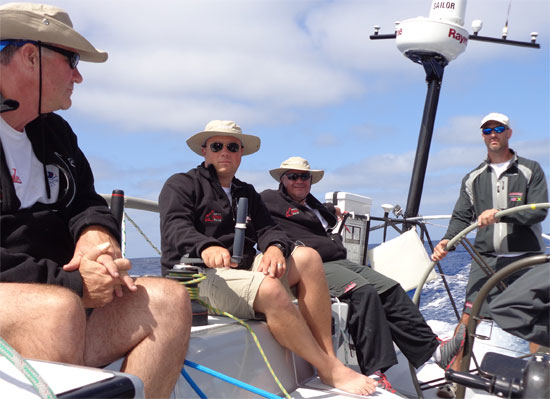The Transpac Race started for us Thursday, July 11th at 1pm PDT. We left from Point Fermin near Long Beach, CA bound for Honolulu, HI. There are 9 boats in our division (#6.) Each of the vessels is similar to our, Bodacious IV, in that they are all 50 or 52 foot Santa Cruz racers, and each like us, carries a crew of nine. Here’s our team.

The Bodacious IV team just before the start of the race. From L to R … Christer Still, Matt Scharl, Chris Pike, John Hoskins, Jim McLaren, John Ayres, Jeff Urbina, Tim Eades & Dave Rearick.
The first night, we were surrounded by the constant baying of seals … a haunting call in the dark of night, to be sure. We also had a visit from some indeterminate species of mammal. It being dark, identifying it with any accuracy was difficult for us. As our crew is mostly from the Great Lakes, none of us are too experienced with the local amalgam of sea life. Once loose in the vast Pacific, you quickly come to realize how inadequate the paltry range of categories for sea life you carry with you are, when put against the greater varieties of species that actually exist all around you out here. It’s another one of those pay attention calls that nature loves to deliver, once you put yourself out there and on the receiving end of live experience.
Cool and overcast conditions prevailed all the way to Saturday morning, when the sun broke through allowing us to shed some clothes for an amazing day of sailing at around 12 knots of boat speed and essentially down the “rhumb line” (a fixed compass position indicating the most direct route) to Hawaii. We were able to do this, because the Pacific High pressure zone had move to the north and west bringing us these great winds.
 Sunday arrived like a gift. We set our spinnakers and went to working our way down the trade wind route to Hawaii, sailing between 14 and 20 knots … in winds coming from our starboard (right) quarter (back corner of the boat) direction. This was giving us steady speeds with a peak speed so far of 17.2 knots!
Sunday arrived like a gift. We set our spinnakers and went to working our way down the trade wind route to Hawaii, sailing between 14 and 20 knots … in winds coming from our starboard (right) quarter (back corner of the boat) direction. This was giving us steady speeds with a peak speed so far of 17.2 knots!
We saw our first flying fish Sunday, which tells us the water is getting warmer … AND we had a squid fly up on deck as well, during one of our sail changes, and leaving some ink stains on the deck. Ancient mariners used to navigate by such natural signs. They knew that such occurrences indicated they were changing latitudes as the temperatures of the water, smell of the sea, angle of the winds, types of fish and sea life are all somewhat specific to certain regions of the sea … not unlike how various plants and animals on land are recognizably native to particular regions.
Crew spirits are high, lots of laughs and barbs zinging back and forth. And on top of that, we are eating like kings! Dinner Sunday was a delicious Veal Moscato courtesy of Chef Pierce Johnson … our French chef friend and long-time crew member who is sitting out the race this year, but who is remembered fondly at every meal. (If you’re interested, here’s a video interview with Pierce about nutrition on boats.)
 Appraising the situation, planning the future …
Appraising the situation, planning the future …
We started our Sunday with the Code 0 sail up, with a staysail as well. Then we switched to the A3 spinnaker, and later to our A2. The spinnakers are those large billowy (and photogenic) sails in the front of the boat. The various sails have different sizes and shapes to use for different wind angles and strengths.
Also, for our friends at Earthwatch Institute – we’ve been keeping an eye out for debris and wildlife. Not too much to report so far, except for the beautiful and wide-open blue waters of the Pacific as far as the eye can see.
For those of you following along and working out the math problems on the Explorer Guides, you can do another calculation and take a guess at when we might arrive in Hawaii! Send us an email with your predictions.
Thanks to all for your support!
– Dave, reporting from Bodacious IV
